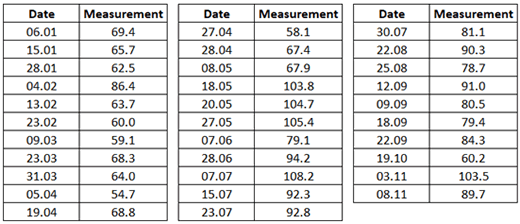Walter Shewhart, father of statistical process control and creator of the control chart, put a premium on the time order sequence of data. Since many statistics and graphs are unaffected by this, you might wonder what the fuss is about. Read on to see why.
|
ADVERTISEMENT |
Figure 1 shows a series of measurements over 11 months. Each measurement value is from one production batch, with the date of each production given. The date is formatted as day first, and month second, meaning that “06.01”—the first measurement of 69.4—is from January 6.
|
|
…


Comments
Shewart and Control Limits
Consider using the same scale on all of the charts(both run and histograms). If you do, it is noticeable that the control limits change when the data sequence changes.
It may also be revealing to place both spec limits and control limits on both run charts and histograms.
Purists may say that spec limits have no place on a control chart but the first observation that could then be made is whether the process control limits (the voice of the process) are inside or outside the spec limits ( the requirements of the customer). One condition would be cause for relaxation, the other for vigilance.
Another observation is that the control limits calculated for the initial data set indicate that the second data set is way out of control. An observation that may not be so obvious with control limits based on the combined data set. The presence of unmoving spec limits as a reference on the same chart may also bring this observation to the forefront.
Control limits and specs
Fully agree that the position, or width, of the control limits is also dependent on the order sequence used. I once had a real example where data were presented in ascending order – the control limits where then extremely narrow (and useless too). Interestingly, as you’ll know but many do not, no matter how we order the data the generic standard deviation statistic never changes.
Spec limits on control charts for individual values? It all depends on the ability of the user to interpret the chart appropriately: I’d guess that in a lot of cases inclusion of the specs leads to an interpretation of the chart that doesn't do justice to the voice of the process because the specs dominate the interpretation. I don’t think it is purist at all, but rather a realisation of the misinterpretation that is likely. If the specs dominate the interpretation, make a time series with the specs on it.
I think we are in full agreement that the specs play a key role in deciding how urgent action is.
Thanks for the comments.
I agree with Scott
I tried training our very smart, creative engineers that it was OK to put spec limits on Individuals (process behavior) charts, but NOT on Xbar charts. Nope, a sizeable portion of the engineers forgot that part of the discussion because, well, most of our engineers are astoundingly good in their discipline but not so much in statistical quality. I had to run around putting fires out when enginers thought control charts were bogus because clearly there were out-of-spec observations, but the Xbar chart was telling them everything was in spec. Worse, managers who saw Xbar charts showing "everything in spec" were sometimes walking away from presentations thinking things were hunky-dory when they weren't.
I've found since that it's much easier to say that specs belong on a completely different plot unless I'm dealing with engineers and managers who have used SPC for a while and get what it's doing. It's a Just Say No kind of message, simple and easy to convey in big red letters on a slide. Just sayin'.
Add new comment